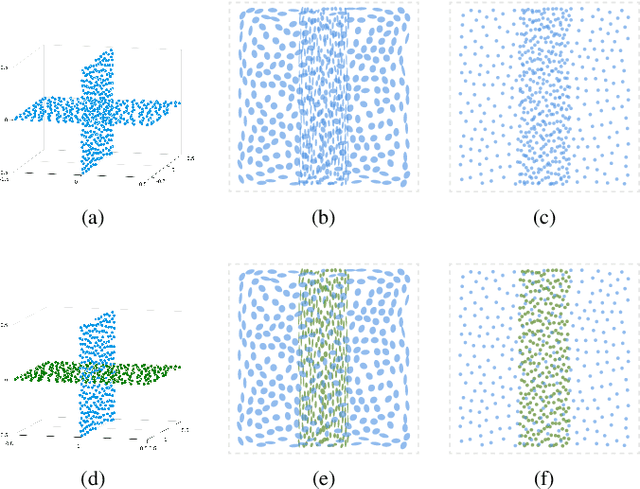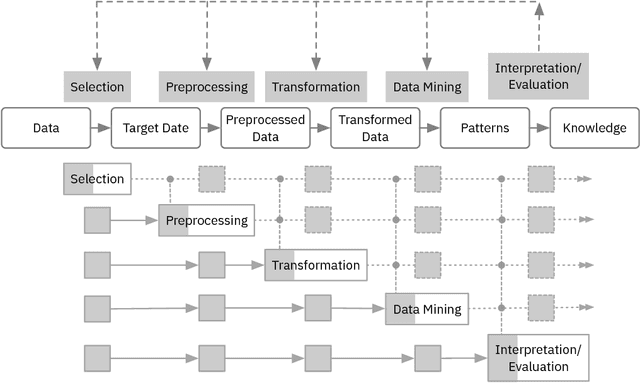Yunhai Wang
SPAC-Net: Rethinking Point Cloud Completion with Structural Prior
Nov 22, 2024Abstract:Point cloud completion aims to infer a complete shape from its partial observation. Many approaches utilize a pure encoderdecoder paradigm in which complete shape can be directly predicted by shape priors learned from partial scans, however, these methods suffer from the loss of details inevitably due to the feature abstraction issues. In this paper, we propose a novel framework,termed SPAC-Net, that aims to rethink the completion task under the guidance of a new structural prior, we call it interface. Specifically, our method first investigates Marginal Detector (MAD) module to localize the interface, defined as the intersection between the known observation and the missing parts. Based on the interface, our method predicts the coarse shape by learning the displacement from the points in interface move to their corresponding position in missing parts. Furthermore, we devise an additional Structure Supplement(SSP) module before the upsampling stage to enhance the structural details of the coarse shape, enabling the upsampling module to focus more on the upsampling task. Extensive experiments have been conducted on several challenging benchmarks, and the results demonstrate that our method outperforms existing state-of-the-art approaches.
Evaluating Task-based Effectiveness of MLLMs on Charts
May 11, 2024Abstract:In this paper, we explore a forward-thinking question: Is GPT-4V effective at low-level data analysis tasks on charts? To this end, we first curate a large-scale dataset, named ChartInsights, consisting of 89,388 quartets (chart, task, question, answer) and covering 10 widely-used low-level data analysis tasks on 7 chart types. Firstly, we conduct systematic evaluations to understand the capabilities and limitations of 18 advanced MLLMs, which include 12 open-source models and 6 closed-source models. Starting with a standard textual prompt approach, the average accuracy rate across the 18 MLLMs is 36.17%. Among all the models, GPT-4V achieves the highest accuracy, reaching 56.13%. To understand the limitations of multimodal large models in low-level data analysis tasks, we have designed various experiments to conduct an in-depth test of capabilities of GPT-4V. We further investigate how visual modifications to charts, such as altering visual elements (e.g. changing color schemes) and introducing perturbations (e.g. adding image noise), affect performance of GPT-4V. Secondly, we present 12 experimental findings. These findings suggest potential of GPT-4V to revolutionize interaction with charts and uncover the gap between human analytic needs and capabilities of GPT-4V. Thirdly, we propose a novel textual prompt strategy, named Chain-of-Charts, tailored for low-level analysis tasks, which boosts model performance by 24.36%, resulting in an accuracy of 80.49%. Furthermore, by incorporating a visual prompt strategy that directs attention of GPT-4V to question-relevant visual elements, we further improve accuracy to 83.83%. Our study not only sheds light on the capabilities and limitations of GPT-4V in low-level data analysis tasks but also offers valuable insights for future research.
Mystique: Deconstructing SVG Charts for Layout Reuse
Aug 09, 2023



Abstract:To facilitate the reuse of existing charts, previous research has examined how to obtain a semantic understanding of a chart by deconstructing its visual representation into reusable components, such as encodings. However, existing deconstruction approaches primarily focus on chart styles, handling only basic layouts. In this paper, we investigate how to deconstruct chart layouts, focusing on rectangle-based ones, as they cover not only 17 chart types but also advanced layouts (e.g., small multiples, nested layouts). We develop an interactive tool, called Mystique, adopting a mixed-initiative approach to extract the axes and legend, and deconstruct a chart's layout into four semantic components: mark groups, spatial relationships, data encodings, and graphical constraints. Mystique employs a wizard interface that guides chart authors through a series of steps to specify how the deconstructed components map to their own data. On 150 rectangle-based SVG charts, Mystique achieves above 85% accuracy for axis and legend extraction and 96% accuracy for layout deconstruction. In a chart reproduction study, participants could easily reuse existing charts on new datasets. We discuss the current limitations of Mystique and future research directions.
An Intelligent Model for Solving Manpower Scheduling Problems
May 07, 2021



Abstract:The manpower scheduling problem is a critical research field in the resource management area. Based on the existing studies on scheduling problem solutions, this paper transforms the manpower scheduling problem into a combinational optimization problem under multi-constraint conditions from a new perspective. It also uses logical paradigms to build a mathematical model for problem solution and an improved multi-dimensional evolution algorithm for solving the model. Moreover, the constraints discussed in this paper basically cover all the requirements of human resource coordination in modern society and are supported by our experiment results. In the discussion part, we compare our model with other heuristic algorithms or linear programming methods and prove that the model proposed in this paper makes a 25.7% increase in efficiency and a 17% increase in accuracy at most. In addition, to the numerical solution of the manpower scheduling problem, this paper also studies the algorithm for scheduling task list generation and the method of displaying scheduling results. As a result, we not only provide various modifications for the basic algorithm to solve different condition problems but also propose a new algorithm that increases at least 28.91% in time efficiency by comparing with different baseline models.
* none
Scribble-Supervised Semantic Segmentation by Uncertainty Reduction on Neural Representation and Self-Supervision on Neural Eigenspace
Feb 19, 2021



Abstract:Scribble-supervised semantic segmentation has gained much attention recently for its promising performance without high-quality annotations. Due to the lack of supervision, confident and consistent predictions are usually hard to obtain. Typically, people handle these problems to either adopt an auxiliary task with the well-labeled dataset or incorporate the graphical model with additional requirements on scribble annotations. Instead, this work aims to achieve semantic segmentation by scribble annotations directly without extra information and other limitations. Specifically, we propose holistic operations, including minimizing entropy and a network embedded random walk on neural representation to reduce uncertainty. Given the probabilistic transition matrix of a random walk, we further train the network with self-supervision on its neural eigenspace to impose consistency on predictions between related images. Comprehensive experiments and ablation studies verify the proposed approach, which demonstrates superiority over others; it is even comparable to some full-label supervised ones and works well when scribbles are randomly shrunk or dropped.
Implicit Multidimensional Projection of Local Subspaces
Sep 07, 2020



Abstract:We propose a visualization method to understand the effect of multidimensional projection on local subspaces, using implicit function differentiation. Here, we understand the local subspace as the multidimensional local neighborhood of data points. Existing methods focus on the projection of multidimensional data points, and the neighborhood information is ignored. Our method is able to analyze the shape and directional information of the local subspace to gain more insights into the global structure of the data through the perception of local structures. Local subspaces are fitted by multidimensional ellipses that are spanned by basis vectors. An accurate and efficient vector transformation method is proposed based on analytical differentiation of multidimensional projections formulated as implicit functions. The results are visualized as glyphs and analyzed using a full set of specifically-designed interactions supported in our efficient web-based visualization tool. The usefulness of our method is demonstrated using various multi- and high-dimensional benchmark datasets. Our implicit differentiation vector transformation is evaluated through numerical comparisons; the overall method is evaluated through exploration examples and use cases.
Deep learning Inversion of Seismic Data
Jan 23, 2019



Abstract:In this paper, we propose a new method to tackle the mapping challenge from time-series data to spatial image in the field of seismic exploration, i.e., reconstructing the velocity model directly from seismic data by deep neural networks (DNNs). The conventional way to address this ill-posed seismic inversion problem is through iterative algorithms, which suffer from poor nonlinear mapping and strong non-uniqueness. Other attempts may either import human intervention errors or underuse seismic data. The challenge for DNNs mainly lies in the weak spatial correspondence, the uncertain reflection-reception relationship between seismic data and velocity model as well as the time-varying property of seismic data. To approach these challenges, we propose an end-to-end Seismic Inversion Networks (SeisInvNet for short) with novel components to make the best use of all seismic data. Specifically, we start with every seismic trace and enhance it with its neighborhood information, its observation setup and global context of its corresponding seismic profile. Then from enhanced seismic traces, the spatially aligned feature maps can be learned and further concatenated to reconstruct velocity model. In general, we let every seismic trace contribute to the reconstruction of the whole velocity model by finding spatial correspondence. The proposed SeisInvNet consistently produces improvements over the baselines and achieves promising performance on our proposed SeisInv dataset according to various evaluation metrics, and the inversion results are more consistent with the target from the aspects of velocity value, subsurface structure and geological interface. In addition to the superior performance, the mechanism is also carefully discussed, and some potential problems are identified for further study.
Progressive Data Science: Potential and Challenges
Dec 19, 2018
Abstract:Data science requires time-consuming iterative manual activities. In particular, activities such as data selection, preprocessing, transformation, and mining, highly depend on iterative trial-and-error processes that could be sped up significantly by providing quick feedback on the impact of changes. The idea of progressive data science is to compute the results of changes in a progressive manner, returning a first approximation of results quickly and allow iterative refinements until converging to a final result. Enabling the user to interact with the intermediate results allows an early detection of erroneous or suboptimal choices, the guided definition of modifications to the pipeline and their quick assessment. In this paper, we discuss the progressiveness challenges arising in different steps of the data science pipeline. We describe how changes in each step of the pipeline impact the subsequent steps and outline why progressive data science will help to make the process more effective. Computing progressive approximations of outcomes resulting from changes creates numerous research challenges, especially if the changes are made in the early steps of the pipeline. We discuss these challenges and outline first steps towards progressiveness, which, we argue, will ultimately help to significantly speed-up the overall data science process.
DifNet: Semantic Segmentation by Diffusion Networks
Oct 26, 2018



Abstract:Deep Neural Networks (DNNs) have recently shown state of the art performance on semantic segmentation tasks, however, they still suffer from problems of poor boundary localization and spatial fragmented predictions. The difficulties lie in the requirement of making dense predictions from a long path model all at once since details are hard to keep when data goes through deeper layers. Instead, in this work, we decompose this difficult task into two relative simple sub-tasks: seed detection which is required to predict initial predictions without the need of wholeness and preciseness, and similarity estimation which measures the possibility of any two nodes belong to the same class without the need of knowing which class they are. We use one branch network for one sub-task each, and apply a cascade of random walks base on hierarchical semantics to approximate a complex diffusion process which propagates seed information to the whole image according to the estimated similarities. The proposed DifNet consistently produces improvements over the baseline models with the same depth and with the equivalent number of parameters, and also achieves promising performance on Pascal VOC and Pascal Context dataset. OurDifNet is trained end-to-end without complex loss functions.
 Add to Chrome
Add to Chrome Add to Firefox
Add to Firefox Add to Edge
Add to Edge